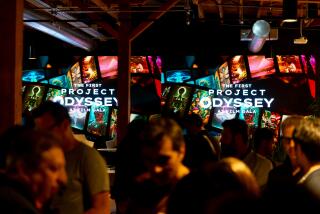Training Its Eye on Digital Frontier
- Share via
Taking a giant leap forward into the future of filmmaking, the nascent Los Angeles Film School rolled out its new digital high-definition cameras that will be used by its students and working professionals to learn about a new technology that could change the way movies are made.
The digital cameras got their first run-through Wednesday in Hollywood from director Philip Noyce (“Patriot Games”) as he filmed one scene for his next movie, “The Quiet American,” based on the Graham Greene novel. Cinematographer Chris Doyle (1998’s “Psycho”) was also on hand to test the equipment.
The year-old L.A. Film School, located on Sunset Boulevard across from the Cinerama Dome, purchased four 24-frame Cine Alta cameras; one is for shooting outside, the other three are for shooting on a sound stage. The cameras and related equipment cost $5 million and are made by Sony. It’s the same digital equipment being used by director George Lucas to shoot the next “Star Wars” movie, now on location in Australia. The film school claims it is the first in the country to purchase such cameras.
“We are here so we can get an idea of what Mr. Lucas is doing down in Australia,” joked Noyce, himself an Australian.
*
Until recently, professional movie makers could only learn to use the high-definition equipment at the Sony digital lab in San Jose.
“The high-definition technology is progressing incredibly rapidly,” said L.A. Film School President Carolyn Pfeiffer. “We are a new school, and for us not to embrace the new technology wouldn’t make sense.” She said the school--a one-year professional training program--will offer classes for professional cinematographers and exchange students from other film schools as well as its own students.
*
Digital high definition is new territory for most directors and cinematographers. Rather than using 35-millimeter film, the images are captured on digital tapes. One of the major advantages of working in digital is that it could radically streamline the costly and time-consuming post-production process.
“We are looking at some of the ways to collapse the production into the post-production process,” said Frank Patterson, associate dean of the film school.
For the test, Noyce directed a scene between Julian Sands and Patrick Bauchau on a small set. As they shot it, Doyle sat in a dark room with the image projected on a large screen. Using a da vinci 2k color enhancement system, which was on loan to the school, Doyle and the colorist were able to fiddle with the visual tone of the image. The color-enhancement system allows the cinematographer to change the look of the movie right away, rather than waiting for post-production. The color ranges can vary from black and white to muted copper tones to high-intensity color. When Doyle finished the color tone, the image was then captured on digital tape.
“The more you can see right before your eyes, the more confident you are of what you are doing,” said Doyle.
Although he is not well versed in digital technology, Doyle said he wanted to try out the new system because he believes it will be the future of movie making.
“We don’t know the parameters of high definition yet,” said Doyle, who’s best known for his work on films from Hong Kong, where he lives. “But then again, we didn’t know how to use a computer until a few years ago, right?”
But not everyone is equally enthused about using the digital technology for filmmaking. Resistance comes from a range of interests, including cinematographers questioning the quality of images on digital, and film manufacturers afraid of losing business.
But as Noyce says, resistance will likely die down once the technology is refined.
“We don’t want to lose the romance of celluloid. I mean, there is something magical in the alchemy between light and film,” he said. “But digital will be able to capture that over time.”
More to Read
The biggest entertainment stories
Get our big stories about Hollywood, film, television, music, arts, culture and more right in your inbox as soon as they publish.
You may occasionally receive promotional content from the Los Angeles Times.










